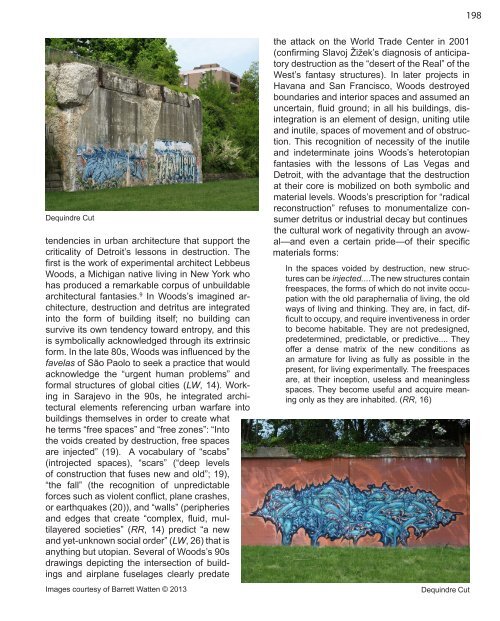Detroit Research Volume 1
Create successful ePaper yourself
Turn your PDF publications into a flip-book with our unique Google optimized e-Paper software.
198<br />
Dequindre Cut<br />
tendencies in urban architecture that sup port the<br />
criticality of <strong>Detroit</strong>’s lessons in destruction. The<br />
first is the work of experimental architect Lebbeus<br />
Woods, a Michigan native living in New York who<br />
has produced a re markable corpus of unbuildable<br />
architectural fantasies. 9 In Woods’s imagined architecture,<br />
destruction and detritus are integrated<br />
into the form of building itself; no building can<br />
survive its own tendency toward entropy, and this<br />
is symbolically acknowledged through its extrinsic<br />
form. In the late 80s, Woods was influenced by the<br />
favelas of São Paolo to seek a practice that would<br />
acknowledge the “urgent human problems” and<br />
formal structures of global cities (LW, 14). Working<br />
in Sarajevo in the 90s, he integrated architectural<br />
elements ref erencing urban warfare into<br />
buildings themselves in order to create what<br />
he terms “free spaces” and “free zones”: “Into<br />
the voids created by destruction, free spaces<br />
are injected” (19). A vocabulary of “scabs”<br />
(introjected spaces), “scars” (“deep levels<br />
of construction that fuses new and old”; 19),<br />
“the fall” (the recognition of unpredictable<br />
forces such as violent conflict, plane crashes,<br />
or earthquakes (20)), and “walls” (peripheries<br />
and edges that create “complex, fluid, multilayered<br />
societies” (RR, 14) predict “a new<br />
and yet-unknown social or der” (LW, 26) that is<br />
anything but utopian. Several of Woods’s 90s<br />
drawings depicting the in tersection of buildings<br />
and airplane fuselages clearly predate<br />
Images courtesy of Barrett Watten © 2013<br />
the attack on the World Trade Center in 2001<br />
(confirming Slavoj Žižek’s diagnosis of anticipatory<br />
destruction as the “desert of the Real” of the<br />
West’s fantasy structures). In later projects in<br />
Havana and San Francisco, Woods destroyed<br />
boundaries and interior spaces and assumed an<br />
uncertain, fluid ground; in all his buildings, disintegration<br />
is an element of design, uniting utile<br />
and inutile, spaces of movement and of obstruction.<br />
This recognition of necessity of the inutile<br />
and indeter minate joins Woods’s heterotopian<br />
fantasies with the lessons of Las Vegas and<br />
<strong>Detroit</strong>, with the advantage that the destruction<br />
at their core is mobilized on both symbolic and<br />
material levels. Woods’s prescription for “radical<br />
reconstruction” refuses to monumental ize consumer<br />
detritus or industrial decay but continues<br />
the cultural work of negativity through an avowal—and<br />
even a certain pride—of their specific<br />
materials forms:<br />
In the spaces voided by destruction, new structures<br />
can be injected....The new structures contain<br />
freespaces, the forms of which do not invite occupation<br />
with the old paraphernalia of living, the old<br />
ways of living and thinking. They are, in fact, difficult<br />
to occupy, and require inventiveness in order<br />
to become habitable. They are not predesigned,<br />
predetermined, predictable, or predictive.... They<br />
offer a dense matrix of the new conditions as<br />
an armature for living as fully as possible in the<br />
present, for living experimentally. The freespaces<br />
are, at their inception, useless and meaningless<br />
spaces. They become useful and acquire meaning<br />
only as they are inhabited. (RR, 16)<br />
Dequindre Cut





